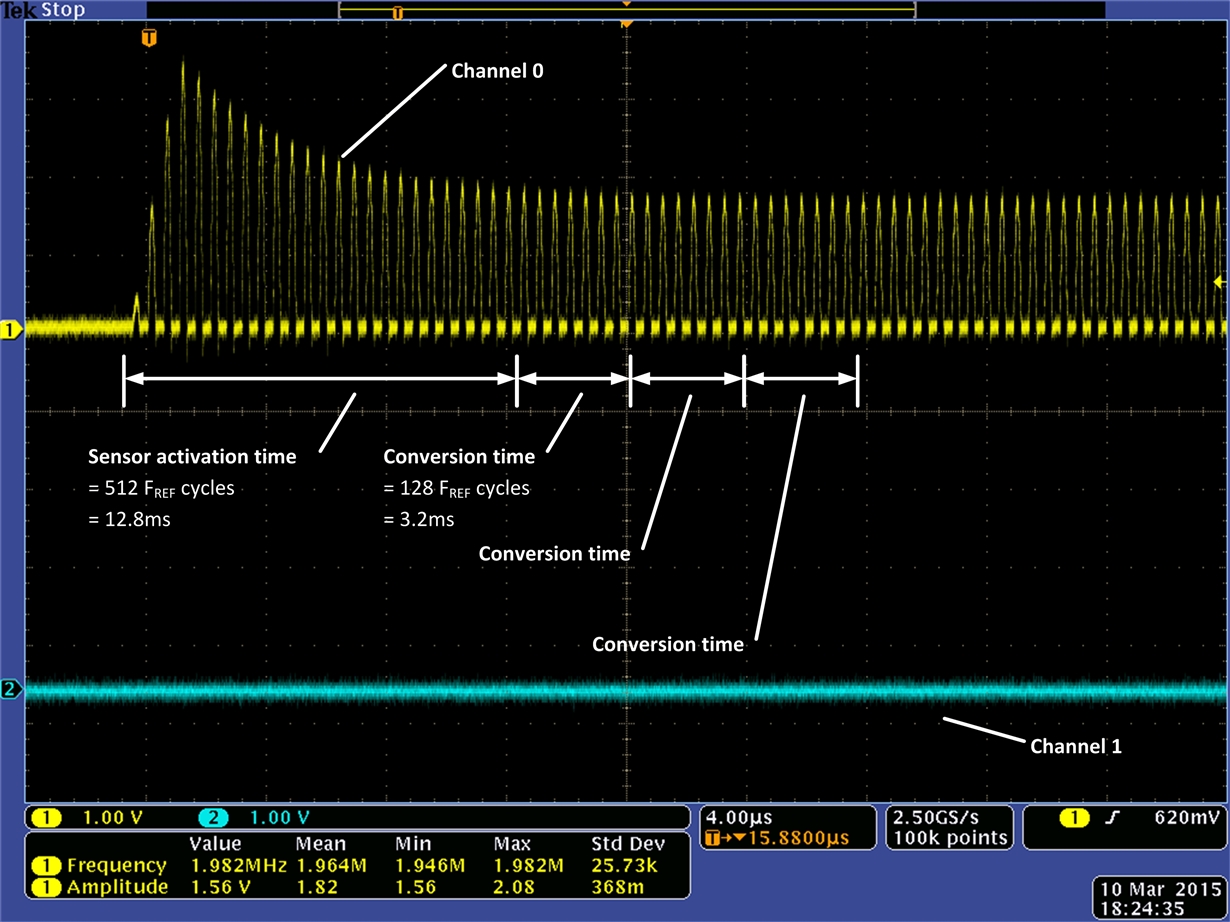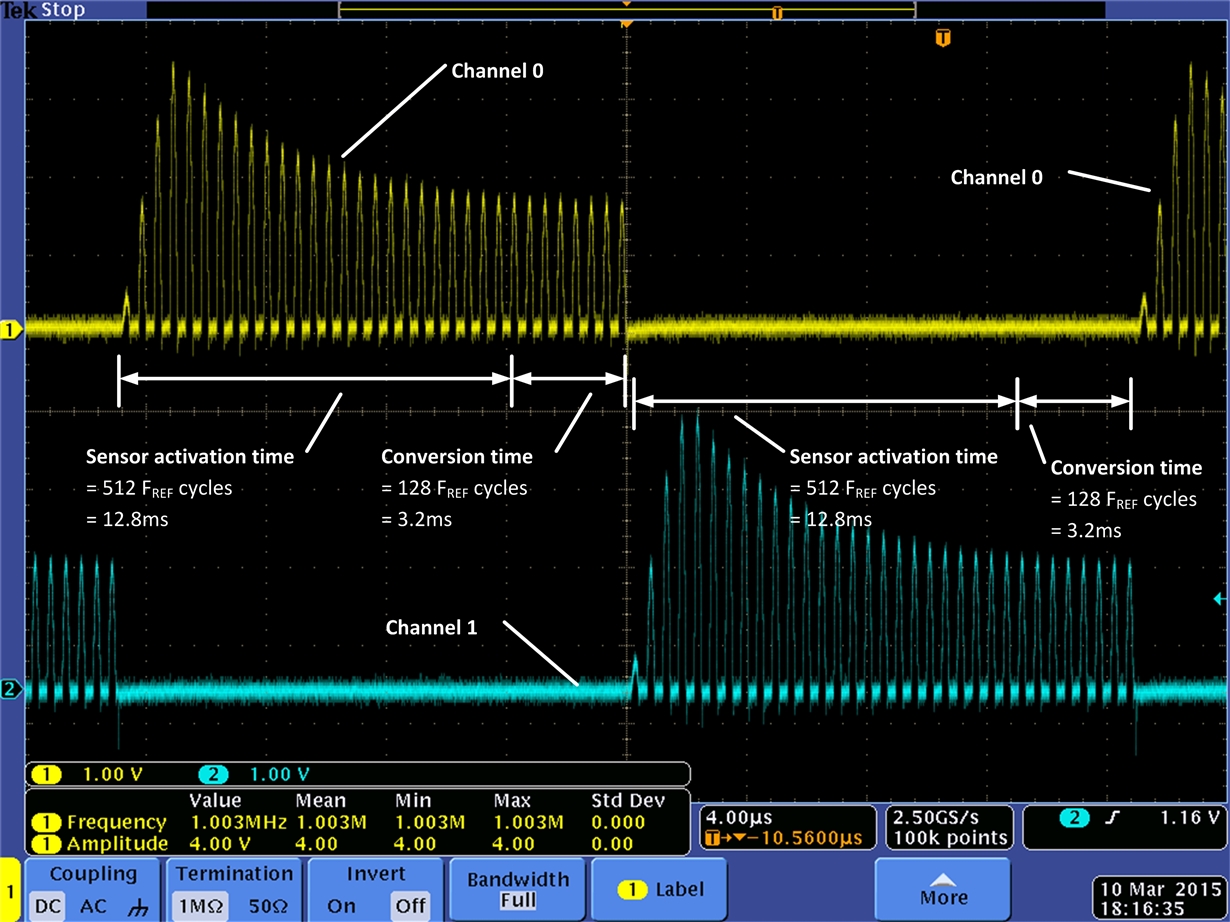SSZTCQ7 May 2015 LDC1312 , LDC1314 , LDC1612 , LDC1614
In my previous post, I explained the benefits and configuration of a multichannel inductive-sensing system with the latest expansion to TI’s inductance-to-digital converter (LDC) portfolio. In this post, I’ll explain how to calculate the timing characteristics of single- and multichannel LDC systems.
Similar to the LDC1000, the new multichannel LDCs have a data-ready signal (DRDY) that can detect when a new data sample is available. Additionally, the timing of the multichannel LDCs is fully deterministic; therefore, it is possible to calculate when a data sample is ready without having to poll the DRDY signal or use the interrupt pin.
The scope plots in Figure 1 and Figure 2 show single-ended measurements of the sensor-input pin in single- and multichannel mode, respectively. In this example, the LDC has been configured with a relatively short conversion time of 128 FREF cycles (CHn_RCOUNT = 0x08), which allows high sample rates at the cost of lower measurement precision.
 Figure 1 Single-channel Configuration
Timing (Single-ended Measurement on IN0A: Yellow and IN1A: Cyan)
Figure 1 Single-channel Configuration
Timing (Single-ended Measurement on IN0A: Yellow and IN1A: Cyan) Figure 2 Dual-channel Configuration
Timing (Single-ended Measurement on IN0A: Yellow and IN1A: Cyan)
Figure 2 Dual-channel Configuration
Timing (Single-ended Measurement on IN0A: Yellow and IN1A: Cyan)Timing of the LDCs is deterministic and can be broken down into:
- Wake-up time. This is the time it takes to wake up the device from shutdown mode to sleep mode.
- Wake-up from sleep time. This is the time that the device needs to change from sleep mode to active mode.
- Sensor-activation time. Sensor-activation time is configured for each channel individually in the SETTLECOUNT_CHn registers in 0x10, 0x11, 0x12 and 0x13. It is possible to select different sensor-activation times if the sensor characteristics differ from channel to channel. This time is specific to the sensor characteristic and should allow sufficient time for the sensor to settle. The time that it takes for an LC tank to settle depends on its Q-factor and its sensor-oscillation frequency. An LC tank with a high Q-factor takes longer to settle than one with a lower Q-factor, and an LC tank with a high sensor frequency settles faster than one with a low sensor frequency. The sensor-activation time applies when a particular sensor is activated. In single-channel mode, it only applies once, when sleep mode is disabled. In multichannel mode, sensors are automatically shut off when not in use, so the sensor-activation time applies every time the LDC switches channels. Setting this time too short for a given sensor design can degrade measurement performance. Setting it longer than it needs to be does not impact performance, but adds an additional delay and is therefore not advisable in applications that rely on high sample rates.
- Conversion time. Frequency measurement takes place during the conversion-time interval, which is set in the RCOUNT_CHn registers in 0x08, 0x09, 0x0A and 0x0B. The time it takes to convert one sample can be between 80 FREF clock cycles (2µs at CLKIN = 40MHz) and 1,048,560 FREF clock cycles (26.2ms at CLKIN = 40MHz). Faster conversion times allow higher sample rates but lower measurement precision, as shown in the application curves of the data sheet. You can choose the conversion-time interval for each sensor individually; therefore, it is possible to meet requirements in systems where different channels have different specifications for measurement precision.
- Switch delay. The channel-switch delay applies in multichannel mode only and is used to shut down one sensor and switch to the next sensor in the sequence.
In summary, in a multichannel system, the dwell-time interval for a single sample is the sum of three parts:
- Sensor-activation time.
- Conversion time.
- Channel-switch delay.
As shown in Figure 2, one conversion takes 1.8ms (sensor-activation time) + 3.2ms (conversion time) + 0.75ms (channel-switch delay) = 16.75ms per channel. If the LDC is configured for dual-channel operation by setting AUTOSCAN_EN = 1 and RR_SEQUENCE = 00, then one full set of conversion results will be available from the data registers every 33.5ms. If the device is configured in quad-channel mode instead (by setting AUTOSCAN_EN = 1 and RR_SEQUENCE = 10), then one full set of conversion results would take 67ms to complete.
To determine the timing in different configurations, see the Inductive Sensing Design Calculator Tool.
If you are using the LDC1312, LDC1314, LDC1612 or LDC1614 in your designs, be sure to check out the next installment in this series, when I’ll talk about the extended-range benefits and superior measurement performance of the LDC1612 and LDC1614.
Additional Resources
- Learn more about inductive sensing.
- Start designing with a multichannel LDC and order the LDC1614 evaluation module.
- Read more blog posts about designing with LDCs, including part 1 of this series.
- Check out this TI Design reference design for a 1-degree dial using the LDC1314.
- Start a design today with WEBENCH® Inductive Sensing Designer.